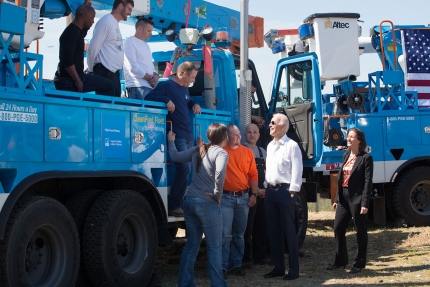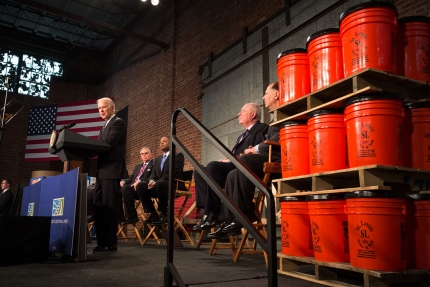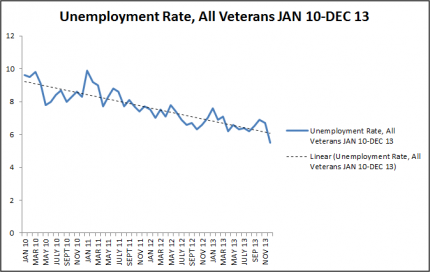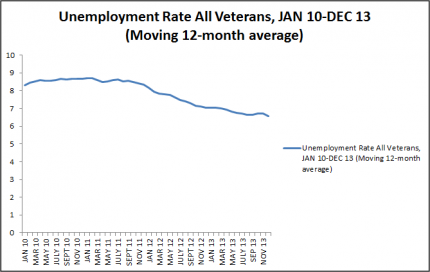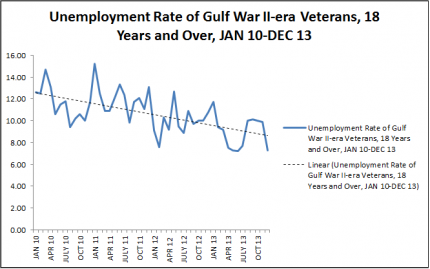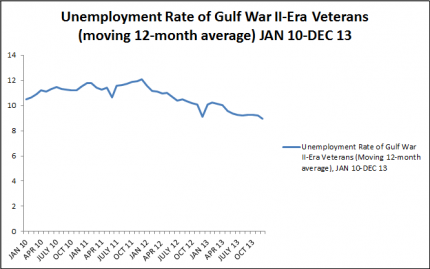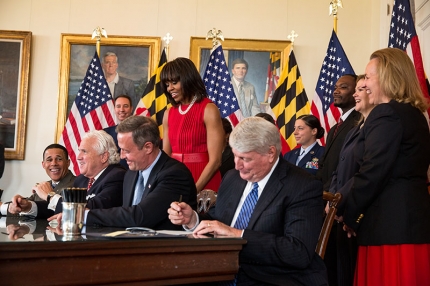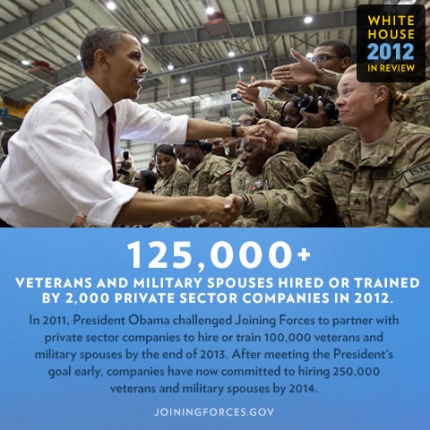Jobs News
Achieving President Obama’s Vision on Training
Posted by on April 17, 2015 at 8:52 AM ESTLast year, the President laid out a vision for our job training system that – as he explained – “trains our workers first based on what employers are telling us they’re hiring for and helps business design the training programs so that we’re creating a pipeline into jobs that are actually out there.” This month, the Administration is taking two key steps to realize that vision – both by partnering with industry and by reforming our own job training system.
Learn more about , EconomyVice President Biden Speaks at America’s Central Port on the Fifth Anniversary of the Recovery Act
Posted by on February 20, 2014 at 1:15 PM EST“The Recovery Act is the largest public works project since President Eisenhower laid out our nation’s interstate highway system—and all of you here at America’s Central Port are continuing this American story of boldness and doing big things that are so deeply ingrained in our history,” Vice President Biden said at an event marking the fifth anniversary of the American Recovery and Reinvestment Act, which saved our country from an economic depression and helped rebuild the middle class.
Speaking on the Mississippi River at America’s Central Port in Granite City, Illinois on Wednesday. February 19, the Vice President outlined how the Recovery Act’s TIGER grants at the port and across the country have modernized the way we do business, created good-paying middle-class jobs, and strengthened our global economic competitiveness.
Joined by Illinois Governor Pat Quinn, former Secretary of Transportation Ray LaHood, current Secretary of Transportation Anthony Foxx, along with local and port officials, the Vice President described how the grants significantly improve the way we finance and strengthen the capacity of our nation’s ports, railroads, and highways. At America’s third largest inland port, the TIGER program has already helped hire workers who installed new levee relief wells, laid down a new rail track, and started work on a new harbor, all of which help increase the Port’s efficiency and reduce shipping costs.
Learn more about , , EconomyThe Fifth Anniversary of the American Recovery and Reinvestment Act
Posted by on February 17, 2014 at 1:00 PM ESTFive years ago, on February 17, 2009, less than a month into his first term, President Obama signed into law the American Recovery and Reinvestment Act of 2009. At the time, the country was experiencing the worst economic crisis since the Great Depression. Private employers had already cut almost 4 million jobs, trillions in dollars in household wealth had been wiped out, and the economy’s total output was in the midst of its sharpest downturn of the postwar era.
As part of the accountability and transparency provisions included in the Recovery Act, the Council of Economic Advisers was charged with providing to Congress quarterly reports on the Act’s effects. The final report in this series—and available HERE—affirms that the Recovery Act had a substantial positive impact on the economy, helped to avert a second Great Depression, and made targeted investments that will pay dividends long after the Act has fully phased out.
In the four years following the Recovery Act, the President built on this initial step, signing into law over a dozen fiscal measures that extended key features of the Act and provided new sources of support. These measures included a temporary payroll tax cut for 160 million working Americans, additional extensions to the Emergency Unemployment Compensation program, expanded business tax incentives, small business tax cuts, and funding to protect teacher jobs.
Learn more about , EconomyVeteran Unemployment Continues to Decline, Lowest Rate in Five Years
Posted by on January 13, 2014 at 5:52 PM ESTLast week, the Bureau of Labor Statistics released Veteran unemployment data for the month of December.The unemployment rate for all Veterans was 5.5 percent last month—a decrease from 6.7 percent in November and more than a point below the national average of 6.7 percent. This is the lowest Veteran unemployment has been in five years.For post-9/11 Veterans, the rate dropped to 7.3 percent in December, compared to 9.9 percent in November – but a when compared to 10.8 percent in December 2012 it’s even more significant.In short, more Veterans are getting hired due to a national focus on hiring Veterans. That is good news, but there is still much more to do to ensure Veterans continue to find meaningful employment. We often send out information on Twitter or Facebook highlighting programs or opportunities for Veteran employment, and as a Veteran I find it gratifying to see the country working to help get our Vets back on their feet in so many ways. From the tech industry, to Red Cross-hosted job fairs, to training in the food service industry, Operation Good Jobs to the National Cemetery Administration’s training program for homeless Veterans, the efforts to combat Veteran unemployment continue to put our Vets to work.Included below are graphs to illustrate the unemployment rate for all Veterans and post 9-11-Veterans. Below, you can see the monthly unemployment rate for all Veterans since January 2010. The long-term trend shows a clear decrease.Learn more aboutValerie Jarrett at the AFL-CIO National Conference on Diversity and Inclusion
Posted by on September 10, 2013 at 9:13 AM ESTOn Sunday September 8th, Valerie Jarrett, Senior Advisor to the President addressed an audience of nearly one thousand AFL-CIO union leaders and allies at their national conference on diversity and inclusion, held this week in Los Angeles. Secretary of Labor, Tom Perez is also scheduled to address the conference on Tuesday.
Learn more about , Economy,Fixing Our Broken Immigration System: The Economic Case for the Agricultural Industry
Posted by on August 13, 2013 at 12:25 PM ESTToday, Jason Berry the owner of Berry Farms in Vivaldia, Georgia joined a call with Secretary of Agriculture Tom Vilsack to highlight the important economic benefits of immigration reform to the agricultural industry. Jason’s company produces 200 acres of organic blueberries, in addition to 50 acres of vegetables. In the spring and summer of 2011 a drastic shortage of farm workers, invoked by the passage of a local law, almost caused him to lose his farm. Desperate for workers, Jason began offering $50 signing bonuses to locals who were willing to work harvesting his crops; however, based on his estimates, 90% of those new hires quit within three days. Jason says the losses at his blueberry and vegetable farm were almost enough to put his small operation under, which would have drastically impacted him and his 15 year round employees. Jason’s story is one echoed by many farmers in Georgia. Jason shared his story with President Obama in late June and continues to use his story to demonstrate why immigration reform is so important to America’s farmers and the entire agricultural industry. Check out Jason’s video here.
Learn more about Economy, ImmigrationYou're Going to Want to Watch This Speech
Posted by on July 21, 2013 at 7:00 PM ESTI just finished reading the draft of a speech the President plans to deliver on Wednesday, and I want to explain why it’s one worth checking out.
Eight years ago, not long after he was elected to the United States Senate, President Obama went to Knox College in his home state of Illinois where he laid out his economic vision for the country. It’s a vision that says America is strongest when everybody’s got a shot at opportunity – not when our economy is winner-take-all, but when we’re all in this together.
Revisiting that speech, it’s clear that it sowed the seeds of a consistent vision for the middle class he’s followed ever since. It’s a vision he carried through his first campaign in 2008, it’s a vision he carried through speeches like the one he gave at Georgetown University shortly after taking office that imagined a new foundation for our economy and one in Osawatomie, Kansas on economic inequality in 2011 -- and it’s a vision he carried through his last campaign in 2012.
Watch that history here and see why this moment is so important.
All of these speeches – Knox College, Georgetown, Osawatomie – make clear that since day one, the President has had one clear economic philosophy: The American economy works best when it grows from the middle-out, not the top down.
Learn more about , Economy,The Employment Situation in June
Posted by on July 5, 2013 at 8:30 AM ESTWhile more work remains to be done, today’s employment report provides further confirmation that the U.S. economy is continuing to recover from the worst downturn since the Great Depression. It is critical that we remain focused on pursuing policies to speed job creation and expand the middle class, as we continue to dig our way out of the deep hole that was caused by the severe recession that began in December 2007.
Today’s report from the Bureau of Labor Statistics (BLS) indicates that private sector businesses added 202,000 jobs last month (see first chart below). Total non-farm payroll employment rose by 195,000 jobs in June. The economy has now added private sector jobs for 40 consecutive months, and a total of 7.2 million jobs has been added over that period. In spite of monthly volatility, over the past three years the pace of job growth has increased each year (see second chart below). So far this year, 1.23 million private sector jobs have been added.
The household survey showed that the unemployment rate remained at 7.6 percent in June down from 8.2 percent a year ago. The labor force participation rate rose by 0.1 percentage point for the second month in a row to 63.5 percent in June.
In the four years since the recession ended in June 2009, the economy has added 5.3 million jobs, thanks to the resilience of the American people and policies like the Recovery Act, which helped bring the recession to an end and put us on the path to recovery. With the recovery gaining traction, now is not the time for Washington to impose self-inflicted wounds on the economy. The President will continue to press Congress to act on the proposals he called for in his State of the Union address to make America a magnet for good jobs, help workers obtain the skills they need for those jobs, and make sure that honest work leads to a decent living.
Learn more about , EconomyStates Step Up to Help Veterans and Spouses Get Back to Work
Posted by on April 17, 2013 at 2:14 PM ESTPresident Obama and the First Lady are committed to doing everything in their power to assist the brave men and women who have served our country in re-entering civilian life and finding employment. Over the last year and a half, the President has overseen the first re-design of the military’s transition assistance program in twenty years; created new tax credits to spur veteran hiring; expanded re-employment services, including the Veterans Job Bank and the Veterans Gold Card; and launched a series of initiatives to expand the number of veterans that get jobs in healthcare and first responder fields. Additionally, under the great leadership of the First Lady and Dr. Biden, Joining Forces has expanded hiring and training partnerships with the private sector in an effort to help our veterans and their spouses get back to work.
Yet, our veterans still face major hurdles as they transition out of the military and into the civilian workforce. According to a 2012 survey by Prudential and Iraq and Afghanistan Veterans of America, 60 percent of survey respondents said they had trouble translating their military skills into civilian job experience, creating a significant barrier to employment. Many high-demand, good-paying jobs like paramedics, truck drivers, nurses, and welders, require either a national certification or state occupational license to be hired, and currently our national and state systems make it very difficult for service members and veterans to obtain these civilian certifications and licenses that directly translate to their military training. Often times service members and veterans are required to repeat education or training in order to receive these occupational credentials, even though much, and in some cases, all, of their military training and experience overlaps with credential training requirements. And employers, many with significant needs for skilled workers, are left waiting for these military members to complete these, oftentimes lengthy, credentialing training programs – programs that many veterans could have taught themselves.
Working Toward a Tech Sector that Reflects America
Posted by on February 1, 2013 at 5:26 PM ESTYesterday, I had the pleasure of speaking at the Technology Inclusion Summit, hosted by Chief Technology Officer Todd Park, the Office of Science and Technology Policy, and the Level Playing Field Institute. It was an amazing gathering of private and public partners who are united in their efforts to expand opportunities for training, education and jobs in technology.
President Obama has always believed that technology is an essential part of growing our economy, creating jobs and remaining globally competitive. The President continues to be committed to encouraging the entrepreneurial spirit in our country, starting with setting a goal of 1 million Science Technology Engineering Math (STEM) graduates over the next decade. This effort also means that we need to collectively act to knock down any barriers that stand in the way.
Last August, during the Tech Inclusion Roundtable, participants came up with some great private-sector initiatives to help drive innovation across every community. Whether it was pioneering new educational tools for students of all ages, bringing technical training to underrepresented communities, or mobilizing tech company CEOs to establish mentoring programs for young people, every one of these initiatives and ideas has the potential to shape America’s future.
The Year in Review: Joining Forces to Hire American Heroes
Posted by on December 30, 2012 at 11:44 AM ESTIn August of 2011, President Obama challenged the private sector to hire or train 100,000 veterans and military spouses by the end of 2013. In August of this year, First Lady Michelle Obama visited Mayport Naval Station in Florida to announce that 2,000 American companies had stepped up to the challenge, and had already exceeded that goal, hiring 125,000 veterans and military spouses more than a year ahead of schedule.
In addition, those companies doubled down on their commitment to our troops and military families and made a new promise, a pledge to hire or train an additional 250,000 of our nation's heroes, including 50,000 military spouses.
Hispanic-American Families Just Can’t Afford Tax Increases
Posted by on December 6, 2012 at 4:11 PM ESTAs the debate over the so-called "fiscal cliff" in Washington continues, much of the conversation centers on deficit reduction, revenues, and tax rates. But what is easily lost in that conversation is the very real meaning this has for families all across America. The fact is Hispanic-American families just can't afford tax increases right now, but that's what will happen if Congress fails to act. In fact the median Hispanic family of four would see their income taxes rise by $2,200. An astounding 99 percent of Hispanic families will be affected.
President Obama is committed to growing our economy from the middle out by ensuring a strong, secure, and thriving middle-class, and is proposing a balanced approach. There is no reason to hold middle-class families hostage while we debate tax cuts for millionaires and billionaires. Below you'll find a link to a fact sheet that shows how Hispanic families will be affected. We're also asking all of you to tell us what $2,000 means to your family's budget. Take a look at our #My2K page, and tell us on twitter what that money means to you.
And download the fact sheet on the Fiscal Cliff and Hispanic-American families here.
Learn more about , EconomyA New Front Door for Immigrant Entrepreneurs
Posted by on November 29, 2012 at 2:20 PM ESTYesterday marked the launch of Entrepreneur Pathways, an online resource center that gives immigrant entrepreneurs an intuitive way to navigate opportunities to start and grow a business in the United States. This new resource was announced during a visit to MIT’s entrepreneurship center by Alejandro Mayorkas, Director of U.S. Citizenship and Immigration Services (USCIS), the Federal agency responsible for administering visa programs.
Immigrant entrepreneurs have always made extraordinary contributions to our Nation’s economic growth and competitiveness, creating jobs and new businesses all across the country. Immigrants started 25 percent of the highest-growth companies in America, including iconic success stories like Intel, Google, Yahoo, and eBay, which together employ an estimated 220,000 people within the United States.
President Obama is committed to attracting the world’s best and brightest entrepreneurs to start the next great companies here in the United States, and Entrepreneur Pathways is an important and concrete next step to facilitating that. For example, imagine that an entrepreneur from another country participates in a startup mentorship program in the United States, raises a first round of funding from investors, and wants to stay here to grow the company and hire more people. Entrepreneur Pathways explains, in plain English, which existing visa categories might be available to that entrepreneur under current law, and what evidence would be necessary to demonstrate eligibility.
Building Careers for Our Older Veterans
Posted by on November 16, 2012 at 6:41 PM ESTWhile much focus has been devoted to education and training for our younger Veterans, we have not lost sight that we have another group who has served our Nation with distinction. Many of this group may already have some education and training, they need additional assistance to prepare them for a changing career market.
In November 2011, the President signed into law the Vow to Hire Heroes Act. This Act does many things to prepare Veterans for careers after military service, including one provision that specifically targets older veterans. The Veterans Retraining Assistance Program, better known as VRAP, is designed to give up to 12 months of benefits for unemployed Veterans to jump-start into a new, high-demand career field. This provision specifically applies to unemployed Veterans who are between 35 and 60, and not eligible for any other education benefit. The law limits the benefit to 99,000 Veterans. Since May, 2012, over 75,000 Veterans have applied and over 62,000 have already been approved to participate in the program.
VRAP doesn’t end with the provision of education; it goes one step further by assisting Veterans find a career. When a Veteran completes the education or training program, they are then eligible to leverage the Department of Labor programs designed for Veterans.
Learn more about , VeteransWeekly Address: Extending Middle Class Tax Cuts to Grow the Economy
Posted by on November 10, 2012 at 5:45 AM ESTPresident Obama says that it’s time for Congress to pass the middle class tax cuts for 98 percent of all Americans. Both parties agree that this will give 98 percent of families and 97 percent of small businesses the certainty that will lead to growth, and so there is no reason to wait. On Tuesday, the American people voted for compromise and action, and the President calls on Congress to come together in that spirit to help create jobs and strengthen our economy.
Transcript | Download mp4 | Download mp3
Learn more about , EconomyAdministration Teams Up to Bring Jobs Back to America
Posted by on September 26, 2012 at 1:30 PM ESTYesterday, the U.S. Departments of Commerce and Labor announced the Make it in America Challenge – a $40 million multi-agency competition that will help accelerate business investments in the U.S. This includes insourcing, where U.S.-based companies bring jobs back, or foreign investment, when foreign companies build factories here and hire American workers to run them.
The competition is being funded by Commerce’s Economic Development Administration and National Institute of Standards and Technology Manufacturing Extension Partnership, and Labor’s Employment and Training Administration. It builds upon the administration’s efforts to strengthen the economy and create jobs by partnering with state, regional, and local partners.
Beginning next year, three-year grants will be available to states, cities, nonprofits, colleges and economic development districts that develop plans to help attract companies that want to build in the U.S. but might need a few more resources.
Learn more about , , , EconomyAdministration's Efforts to Promote Travel and Tourism Are Working
Posted by on September 19, 2012 at 12:54 PM ESTThe Obama Administration's number one priority is to strengthen our economy, create jobs, and restore economic security for the middle class. One way to help strengthen the economy is to make the U.S. the top destination for international visitors. Since the President issued an Executive Order in January and the National Travel and Tourism Strategy was subsequently released by this Administration in May, the Departments of Commerce, Homeland Security, Interior, and State have put a priority on expanding travel to and within the U.S., while remaining vigilant in protecting our national security.
Today, we learned that these efforts are working. The U.S. Department of Commerce announced that international visitors spent an estimated $13.7 billion on travel to, and tourism-related activities within, the United States during the month of July--$350 million (3 percent) more than was spent in July 2011. Travel and tourism-related exports have increased, on average, more than $1.1 billion a month during the first seven months of 2012.
Also today, the Bureau of Economic Analysis (BEA) released estimates for the second quarter 2012 from their Travel and Tourism Satellite Accounts. These accounts present a detailed picture of travel and tourism activity and its role in the U.S. economy, including estimates of spending by travelers in six categories of goods and service as well as estimates of the employment generated by travel and tourism and related industries. Today's data reveal that real spending on travel and tourism increased at an annual rate of 2.1 percent in the second quarter of 2012 after increasing 4.9 percent (revised) in the first quarter of 2012, supporting 7.6 million jobs.
Recent visitors can access the newly redesigned recreation.gov, the federal government's one-stop shop for trip planning and reservations on public lands, such as national parks, wildlife refuges, waterways, forests and recreation areas. This year alone, more than 6 million people have visited the site to learn more about exploring America's great outdoors. A key feature of the new site is suggested travel itineraries to several top destinations for international visitors - Denver, Las Vegas, Miami, Los Angeles and San Francisco. These pre-planned circuits encourage travelers to expand their itineraries by one or more days to take in lesser-known destinations. Longer visits and more expansive itineraries will translate to more tourism dollars and more jobs in the leisure and hospitality industry throughout the U.S.
Learn more about , EconomyThe Employment Situation in August
Posted by on September 7, 2012 at 8:30 AM ESTWhile there is more work that remains to be done, today’s employment report provides further evidence that the U.S. economy is continuing to recover from the worst downturn since the Great Depression. It is critical that we continue the policies that are building an economy that works for the middle class as we dig our way out of the deep hole that was caused by the severe recession that began in December 2007. To create more jobs in particularly hard-hit sectors, President Obama continues to support the elements of the American Jobs Act that have not yet passed, including further investment in infrastructure to rebuild our Nation’s ports, roads and highways, and assistance to State and local governments to prevent layoffs and to enable them to rehire hundreds of thousands of teachers and first responders. To build on the progress of the last few years, President Obama has also proposed an extension of middle class tax cuts that would prevent the typical middle class family from facing a $2,200 tax increase next year.
Today’s report from the Bureau of Labor Statistics (BLS) shows that private sector establishments added 103,000 jobs last month, and overall non-farm payroll employment rose by 96,000. The economy has now added private sector jobs for 30 straight months, for a total of 4.6 million jobs during that period.
The household survey showed that the unemployment rate declined from 8.3 percent to 8.1 percent in August.
Employment rose notably in leisure and hospitality (+34,000), professional and business services (+28,000), health care and social assistance (+21,700), and wholesale trade (+7,900). Manufacturing lost 15,000 jobs, including a 7,500 drop in motor vehicles and parts, which is partly payback for there having been relatively few seasonal auto plant shutdowns in July. Over the past 30 months, manufacturers have added more than 500,000 jobs. Government lost 7,000 jobs, as state government payrolls fell by 6,000 and local governments shed 4,000 jobs. Since February 2010, State and local governments have lost 504,000 jobs.
Learn more about , EconomyWhite House Business Council American Economic Competitiveness Forum Talks Transportation Infrastructure
Posted by on August 27, 2012 at 8:54 AM ESTEd. Note: This is cross-posted from The Fast Lane -- the blog of the Department of Transportation.
Yesterday, I joined several of my DOT colleagues for a White House Business Council forum on American Economic Competitiveness focused on transportation infrastructure. It was great to sit down with businessmen and women from across the country; listen to their concerns and ideas; and discuss the Administration's initiatives on economic development, freight and passenger movement, and infrastructure financing.
It was exciting to meet with business leaders who understand that our transportation policies affect their bottom lines, and we heard over and over yesterday that transportation is an important priority for local chambers of commerce and their members.
Without freight corridors --whether air, sea, river, road, or rail-- businesses can't get access to raw materials or move their products to market. Without adequate transportation, employees can't get to their jobs and can't travel to meet distant vendors and customers to help grow their enterprises.
Learn more about EconomyInternational Traveler Spending On Pace For a Record Setting Year
Posted by on August 23, 2012 at 10:50 AM ESTEd. Note: This is cross-posted from commerce.gov.
Travel and tourism spending by international visitors is helping to boost the U.S. economy. The U.S. Department of Commerce released data yesterday showing that international visitors have spent an estimated $82.2 billion on U.S. travel and tourism-related goods and services year to date, an increase of 11 percent when compared to the same period last year. Many people do not know that this boosts exports – when foreign citizens travel to America and buy goods and services from American companies, that counts as a U.S. export. The new data indicate that the first half of 2012 set a new record for U.S. travel and tourism exports, and, if these trends continue, international visitors could end up injecting close to $170 billion into the U.S. economy by year-end.
These increases help explain why the Obama administration is working hard to make the United States the top destination for international travelers. The U.S. Departments of Commerce and Interior are implementing the National Travel and Tourism Strategy, which they presented to the President in May. The National Strategy is a blueprint for expanding travel to and within the U.S., setting out the goal of attracting over 100 million international visitors annually by 2021, more than a 50 percent increase over the number expected this year. These international visitors would spend an estimated $250 billion per year, creating jobs and spurring economic growth in communities across the country.
Learn more about Economy, Additional Issues
